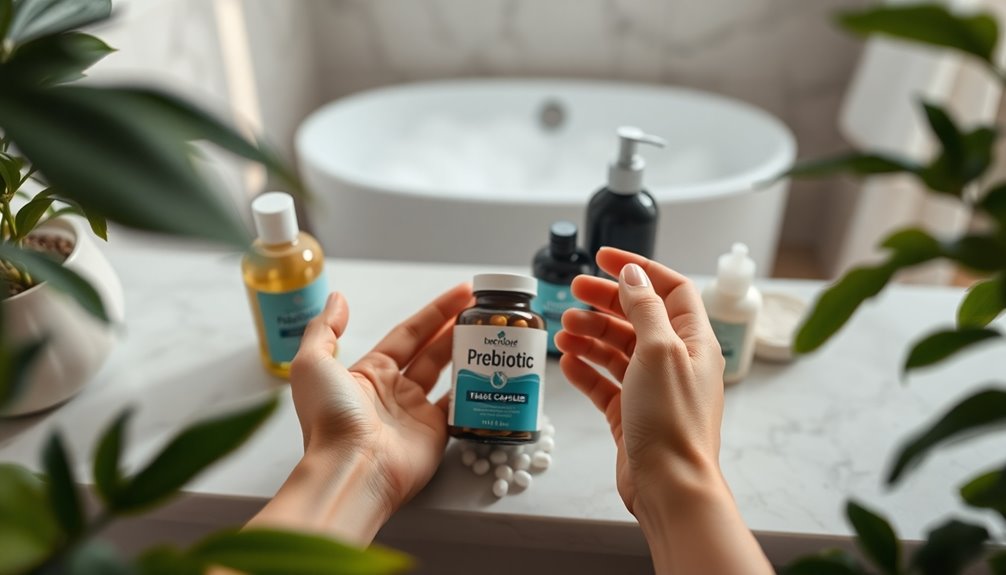Yes, you can get a yeast infection from sex. Sexual activity can disrupt your vaginal flora, leading to an imbalance that promotes yeast growth. Friction and warmth can also create a moist environment ideal for infections. If your partner has a penile yeast infection or you share sex toys, the risk increases due to the transfer of bacteria. Be alert for symptoms like itching, burning, or unusual discharge. Taking preventive steps, like using protection and maintaining dryness after sex, can help. There's more to explore about prevention and treatment options available to you.
Key Takeaways
- Sexual activity can disrupt the vaginal microbiome, potentially leading to yeast overgrowth and infections.
- Friction and warmth from sex may increase moisture, creating an environment favorable for yeast proliferation.
- Partners with a penile yeast infection can transmit bacteria, raising the risk of vaginal yeast infections.
- Maintaining vaginal dryness and hygiene after intercourse can help prevent yeast infections.
- Using protection during sexual activity can reduce the risk of infections by limiting bacterial transfer.
Overview of Yeast Infections

Yeast infections, often a source of discomfort, affect many women at some point in their lives. A vaginal yeast infection is primarily caused by the overgrowth of *Candida albicans*, a fungus that normally lives in the vagina.
About 75% of women will experience at least one yeast infection in their lifetime. You might notice symptoms of a yeast infection, including intense itching, burning during urination or intercourse, and thick, white discharge that resembles cottage cheese.
Factors like hormonal changes, antibiotic use, and moisture from sexual activities can increase your risk.
Diagnosis typically involves a pelvic exam and lab tests to rule out other conditions, ensuring you get the right treatment for your discomfort.
How Sex Affects Vaginal Flora

Sexual activity can considerably impact your vaginal flora, as it introduces new bacteria and alters the delicate balance of microorganisms that normally reside there.
When you engage in penetrative sex, changes in vaginal pH can create an environment that promotes yeast growth if your natural flora is disturbed. The friction and warmth generated during sex can also increase moisture in the vaginal area, further encouraging yeast proliferation.
If your partner has a penile yeast infection, your risk of developing a vaginal yeast infection rises, even though yeast infections aren't classified as sexually transmitted infections.
Additionally, using shared sex toys can facilitate the transfer of bacteria that disrupt your normal vaginal microbiome, contributing to yeast infections.
Symptoms to Watch For

When dealing with a yeast infection, it's essential to recognize the symptoms you might experience.
Women often notice intense itching, irritation, and a thick, white discharge, while men may experience discomfort and unusual odors.
Being aware of these signs helps you seek the right treatment promptly.
Symptoms in Women
While many women experience discomfort at some point, recognizing the symptoms of a yeast infection is essential for prompt treatment.
Here are some common vaginal symptoms to watch for:
- Intense itching and irritation – This can lead to significant discomfort and may worsen if left untreated.
- Thick, white discharge – Often resembling cottage cheese, this discharge is typically odorless but may have a slight yeast-like smell.
- Pain or burning sensations – You might feel pain during urination or sexual activity, which can be quite distressing.
If these symptoms persist for more than a week after treatment or keep coming back, it's advisable to consult a healthcare provider for further evaluation.
Symptoms in Men
Yeast infections in men, though less common than in women, can still lead to uncomfortable symptoms that shouldn't be ignored.
If you notice a rash on the head of your penis or any slight discharge, it could indicate a penile yeast infection. Pay attention to infection symptoms like pain during urination or sexual activity, as these may signal an underlying issue that requires medical evaluation.
Itching or irritation around your genital area can also suggest a yeast infection. Remember, there's about a 15% chance of transmitting a penile yeast infection from a partner with a vaginal yeast infection, so communication is key.
If your symptoms persist or worsen, consult a healthcare provider for proper diagnosis and treatment.
Risk Factors for Infection

Engaging in sexual activity can considerably increase your risk of developing a yeast infection due to various factors at play.
Here are some key risk factors to take into account:
- Bacterial Disruption: Sexual intercourse can introduce new bacteria, disrupting the balance of vaginal flora.
- Hormonal Changes: Fluctuations during sexual activity can alter vaginal pH, creating an environment that promotes yeast overgrowth.
- Weakened Immune System: Individuals with a compromised immune system, poorly managed diabetes, or those taking antibiotics face a higher risk of yeast infections after sex.
Male Yeast Infection Symptoms

A male yeast infection, though less common than in women, can still occur and lead to uncomfortable symptoms.
You might notice a red, inflamed rash on the head of your penis, which can be alarming. Along with this rash, you could experience a slight discharge, often accompanied by itching or irritation in the genital area.
Pain during urination or sexual activity may also arise, causing additional discomfort. If you find yourself dealing with these symptoms, it's important to seek medical evaluation.
Confirming the diagnosis is vital for receiving appropriate treatment, as ignoring these signs can lead to more significant issues. Don't hesitate to reach out to a healthcare professional for guidance.
Prevention Strategies

To effectively prevent yeast infections, it's vital to adopt a few simple strategies.
These practices can help maintain your vaginal flora and minimize moisture retention, reducing the risk of infections:
- Use Protection: Always use condoms, finger condoms, or dental dams during sexual activity to prevent introducing bacteria.
- Stay Dry: After intercourse, wipe away any fluids to reduce moisture retention, which encourages yeast growth.
- Choose the Right Underwear: Wear breathable cotton underwear instead of tight or synthetic fabrics to keep the vaginal area dry.
Additionally, avoid douching and scented hygiene products that disrupt the natural balance of bacteria.
If you have diabetes, maintaining stable blood sugar levels is important to prevent yeast infections.
Treatment Options Available

When dealing with a yeast infection, understanding your treatment options is vital for a swift recovery. Over-the-counter antifungal treatments like miconazole (Monistat) and clotrimazole (Lotrimin) can effectively manage mild infections without a prescription.
However, if your symptoms are severe or recurrent, you may need prescription antifungal medications such as fluconazole (Diflucan), which requires evaluation by a healthcare provider.
While home remedies are popular, their effectiveness varies, so consulting a healthcare provider is important for tailored treatment plans.
Remember that antifungal treatments can weaken latex condoms, so consider alternative birth control methods during treatment to avoid unintended pregnancy.
Prioritizing the right treatment options guarantees a quicker return to comfort and health.
When to Seek Medical Help

If your symptoms persist after treatment or if you notice unusual discharge or bleeding, it's time to seek medical help.
Recurrent infections, especially four or more times a year, also signal a need for professional evaluation.
Don't hesitate to consult a healthcare provider when these concerns arise; getting the right guidance is essential for your health.
Persistent Symptoms After Treatment
Although many yeast infections can be effectively treated with over-the-counter antifungal medications, persistent symptoms after treatment warrant a closer look.
If you're experiencing ongoing discomfort, it's important to consult a healthcare provider. Here are some key signs to watch for:
- Symptoms last more than a week after treatment.
- You have recurrent yeast infections, defined as four or more within a year.
- You notice a lack of improvement despite consistent treatment.
These persistent symptoms could indicate underlying issues, such as diabetes or immune disorders, and may require different therapeutic approaches.
It's essential to differentiate between yeast infections and other conditions to guarantee proper treatment and avoid complications.
Don't hesitate to seek help if you're unsure.
Unusual Discharge or Bleeding
Persistent symptoms after treatment can lead to concerns about other potential issues, especially when you notice unusual discharge or bleeding.
Discharge that appears green or gray isn't typical for a yeast infection and may indicate a different infection, so it's important to get a medical evaluation.
If you experience bleeding outside of your menstrual cycle, particularly if it's accompanied by pain or unusual discharge, don't hesitate to consult a healthcare professional.
Additionally, if your symptoms persist or worsen despite treatment, seeking medical help is necessary to rule out other underlying conditions.
Recurrent Infections Discussion Needed
Experiencing recurrent yeast infections can be frustrating and concerning, especially when they disrupt your daily life. If you're facing this issue, it's vital to consult a healthcare provider.
Here are three key reasons to seek medical help:
- You've had four or more infections within a year, indicating potential underlying causes.
- Your symptoms persist for over a week despite using over-the-counter antifungal treatments, suggesting an alternative diagnosis.
- Differentiating between yeast infections and other conditions, like STDs, is significant for proper treatment.
Discussing these recurrent infections with a healthcare provider can help identify factors such as diabetes, hormonal changes, or immune system issues.
Early intervention can provide quicker relief and prevent further complications.
Additional Resources for Teens

What resources can you turn to if you think you might have a yeast infection? Understanding the symptoms, like itching or thick discharge, is essential. It's also important to learn about safe sex practices to maintain vaginal health. Here's a helpful table with resources:
| Type of Resource | Description | Where to Find |
|---|---|---|
| Health Clinics | Professionals can provide advice | Local community |
| Educational Materials | Books and websites about yeast infections | School library or online |
| Trusted Websites | Reliable info on sexual health | Health organization sites |
Accessing these resources can empower you to ask questions and seek help about yeast infections and your sexual health. Don't hesitate to reach out!
Frequently Asked Questions
Why Do I Get a Yeast Infection After Sex?
If you're getting yeast infections after sex, it might be due to several factors.
The friction and moisture during intercourse can create micro-tears in your vaginal lining, making it easier for yeast to thrive. Hormonal changes can also alter your vaginal pH, promoting yeast growth.
Additionally, if your partner has a yeast infection or if you use moist sex toys, those can increase your risk of developing an infection.
Stay aware of these factors!
Can a Man Give a Woman a Yeast Infection?
You might be surprised to learn that a man can indeed contribute to a woman's yeast infection. If he's a yeast infection, it can transfer during intimate contact.
Even if he shows no symptoms, his presence could disturb the delicate balance of vaginal flora.
Why Does My Girlfriend Keep Getting Yeast Infections?
If your girlfriend keeps getting yeast infections, it could be due to various factors.
Hormonal changes, like those during her menstrual cycle, can disrupt her vaginal flora. Tight clothing or synthetic fabrics might also trap moisture, creating a perfect environment for yeast to thrive.
Additionally, if she's diabetes or fluctuating blood sugar levels, those could increase her susceptibility.
Open communication about hygiene and protective measures can help minimize these issues.
Can a Guy Coming in You Cause a Yeast Infection?
Imagine the intimacy of a moment disrupted by discomfort.
If a guy comes inside you, it doesn't directly cause a yeast infection, but it can create a moist environment that encourages yeast growth, especially if your vaginal flora is already off balance.
Factors like hormonal changes and pH shifts during sex play a role, too.
It's crucial to communicate openly with your partner and seek treatment if symptoms arise.
Conclusion
So, it turns out that while you might think sex is all about pleasure, it can also stir up some unwelcome guests like yeast. Isn't it ironic? You're getting close to someone, but your body might decide to throw a party for the wrong reasons. Staying informed and practicing good hygiene can help keep those pesky infections at bay. Remember, a little prevention goes a long way, and you definitely want to skip the yeast in your love life!










